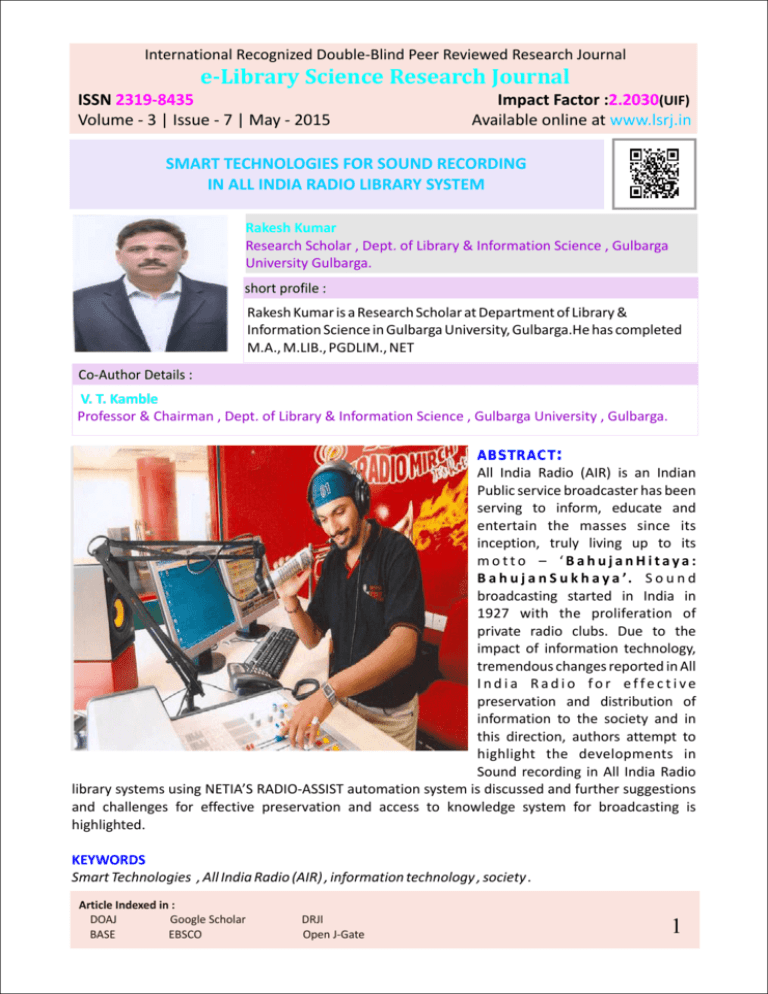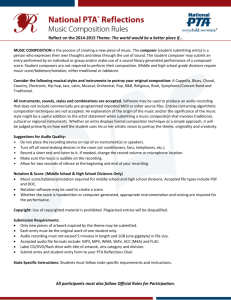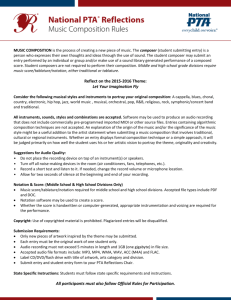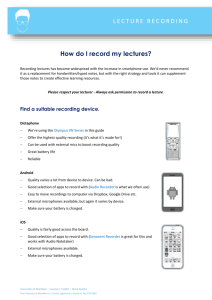Rakesh Kumar - International Recognition Multidisciplinary
advertisement

International Recognized Double-Blind Peer Reviewed Research Journal e-Library Science Research Journal ISSN 2319-8435 Volume - 3 | Issue - 7 | May - 2015 Impact Factor :2.2030(UIF) Available online at www.lsrj.in SMART TECHNOLOGIES FOR SOUND RECORDING IN ALL INDIA RADIO LIBRARY SYSTEM Rakesh Kumar Research Scholar , Dept. of Library & Information Science , Gulbarga University Gulbarga. short profile : Rakesh Kumar is a Research Scholar at Department of Library & Information Science in Gulbarga University, Gulbarga.He has completed M.A., M.LIB., PGDLIM., NET Co-Author Details : V. T. Kamble Professor & Chairman , Dept. of Library & Information Science , Gulbarga University , Gulbarga. ABSTRACT: All India Radio (AIR) is an Indian Public service broadcaster has been serving to inform, educate and entertain the masses since its inception, truly living up to its motto – ‘BahujanHitaya: B a h u j a n S u k h a y a ’. S o u n d broadcasting started in India in 1927 with the proliferation of private radio clubs. Due to the impact of information technology, tremendous changes reported in All India Radio for effective preservation and distribution of information to the society and in this direction, authors attempt to highlight the developments in Sound recording in All India Radio library systems using NETIA’S RADIO-ASSIST automation system is discussed and further suggestions and challenges for effective preservation and access to knowledge system for broadcasting is highlighted. KEYWORDS Smart Technologies , All India Radio (AIR) , information technology , society . Article Indexed in : DOAJ Google Scholar BASE EBSCO DRJI Open J-Gate 1 SMART TECHNOLOGIES FOR SOUND RECORDING IN ALL INDIA RADIO LIBRARY SYSTEM 1.INTRODUCTION The operations of All India Radio began formally in 1936, as a government organization, with clear objectives to inform, educate, and entertain the masses.When India attained Independence in 1947, AIR had a network of six stations and a complements of 18 transmitters. The coverage was 2.5% of the area and just 11% of the population. Rapid expansion of the network took place postIndependence. In 1997, AIR came under PrasarBhasati. Director General, All India Radio is responsible for the overall administration of the entire Akashvani network consisting of 277 stations and 432 broadcast transmitters (148 are MW (Medium Wave), 236 FM (Frequency Modulation) and 48 SW (Short Wave) transmitters as on 31.03.2012), which provide coverage to 99% of the population spread over the country. The storage media used in All India Radio are Type of media • Gramophone record • Analog magnetic tape • Hard disks • Analog Cassette tape • Digital audio tape and its details • Compact disks (CDs) • Mini Disk • Flash memory card • Digital versatile disks (DVDs) and DVD audio Year of Introduction 1910 1940 1950 1963 1980 1980 1990 1990 1990 A special project was launched in 2001 to digitize all Sound Archival recordings into three electronic formats. viz.1.Audio-CD format,WAVE-CD format andCompressed CDs.This project was completed in 2005. By this Akashvani has become one of the major digital libraries in the broadcasting network. Since 2002 All India Radio central archive releases music albums under the banner‘AkashvaniSangeet”. So far we have released 28 albums and the releases in 2005-06 were Ustad Ameer Khan, Pt.Krishnarao Shankar Pandit, T. Brinda/ T. Mukta, T.N. RajaratnamPillai, T. Chowdiah, Pt.Kumar Gandharva, Dagar Brothers, Ustad Allauddin Khan and Pt. Nikhil Banerjee. The releases expected in the coming months are Ustad Bade Ghulam Ali Khan, Badi MotiBai/ZohraBai/JaddanBai, Begham Akthar and Chembai Vaidyanatha Bhagavatar. 2.DIGITIZATION OF SOUND USING NETIA RADIO- ASSIST AUTOMATION SYSTEMS: Sound is produced when objects vibrate producing pressure waves that can be picked up by human’s ear. The vibrating pressure wave’s move in a pattern called waveform. If we graph the intensity or motion of the wave over time, we can get a curve consisting of a series of waveforms. We can say that, sound is stored by waves. These are analog signals. In other words, analog signals are continuous variable signals that consist of waves. When the sound is needed to be used in any computer Article Indexed in : DOAJ Google Scholar BASE EBSCO DRJI Open J-Gate 2 SMART TECHNOLOGIES FOR SOUND RECORDING IN ALL INDIA RADIO LIBRARY SYSTEM application, we need to convert the air vibrations of sound into an electrical signal, which is called digital signal- a stream of 0’s and 1’s. The process of conversing analog signals to digital signals is called digitizing. All India Radio is implementing radio news and studio automation system at its 48 radio stations with the NETIA’s Radio Assist 8 automation systems family of digital audio software programs developed by France based company NETIA. The installation of NETIA software at these stations comprises over 1000 workstations. NETIA's Radio-Assist covers each part of the production and broadcast workflow, allowing users to record, edit, or prepare a playlist. In addition to browse and publishing tools for full multimedia functionality, the software features tools for acquisition, archiving, audio editing, commercial and music production, newsroom systems, scheduling, broadcasting, and administration. Due to its Unicode compatibility, the NETIA software will enable All India Radio to broadcast in 17 different languages and dialects. Radio-Assist covers the entire digital audio workflow of radio station is scalability; whatever the asset, audio, text, image or video. The modular structure of the Radio-Assist range means it is easily assimilated into existing systems and allows ingest, editing, scheduling, broadcast, multicast, archiving, data security and administration via a single user interface. Cover the entire radio workflow from ingest through on-air and beyond! Recording, production, scheduling and automation a single Radio-Assist graphic user interface provides simultaneous access to several production modules. From within a single interface, the user can record and edit, even while still recording, manage assets with numerous associated metadata, or prepare a playlist using voice-tracking. Whether networked or standalone, all Radio-Assist users have fast access and sharing of content thanks to a powerful semantic search engine and content enrichment system. Broadcast can be automated or live-assist for both traditional On-Air, or multi-platform distribution. 3. HARDWARE INFRSTRUCTURE: The Radio automation system has been implemented by setting up a Local Area network (LAN) at each of AIR stations. The LAN setup built at the stations has following main components: 1Doman Controller (1 No) 2Additional Domain Controller (1No) 3Database Server (2 No) 4Storage Area Network 5Workstations 6Firewall In the Local Area Network, 4 no of servers have been deployed along with other workstations. The network operating system deployed for the purpose is Windows Server 2008.Active directory has been implemented to authorize and authenticate the users at each of the station. One server, known as primary domain controller (PDC), manages the master user database for the domain. Second server has been designated as additional Domain controller. The primary domain controller periodically sends copies of the database to the backup domain controllers. An additional domain controller can step in as Article Indexed in : DOAJ Google Scholar BASE EBSCO DRJI Open J-Gate 3 SMART TECHNOLOGIES FOR SOUND RECORDING IN ALL INDIA RADIO LIBRARY SYSTEM primary domain controller, if the PDC server fails and can help balance the work load if the network is busy enough. Database servers (2No) have been deployed in high availability mode and they have been configured to work in active-passive mode. The cluster of database running on MS SQL 2012 server use the storage Area Network to store the audio and data required by application software viz. Radio Assist for necessary operations in an automated studio/ news room environment. In the work stations, other modules like AIRDDO. Snippet, Snippet+, Grid editor, Auto logger, Ingest etc. of Radio Assist have been deployed as per the requirement. A hardware firewall has been installed to protect the network from WAN/Internet. The Radio-Assist has been designed for a specific need and has a wide range of functions. With its modular structure, it can adapt to wide requirements of radios and easily assimilated into existing systems. It allows ingest, editing, scheduling, broadcast, multicast, archiving, data security and administration via a single user interface. Fig.1 Various Modules of Radio Assist. NETIA’s Radio Automation System 4. MANUAL ACQUISITION: 4.1Record: The spectrum of the sound file is generated in real time. At any time, the user can rework the recording, start it again, do several takes to decide which is the best etc. Many situations are allowed for, such as reset when the user changes, program exit impossible when recording is in progress, edit while record, immediate transfer of the recording in progress to the edit tab, IP flow record, etc. Article Indexed in : DOAJ Google Scholar BASE EBSCO DRJI Open J-Gate 4 SMART TECHNOLOGIES FOR SOUND RECORDING IN ALL INDIA RADIO LIBRARY SYSTEM Fig. 2 Recording 4.2 Import: A wide variety of digital audio supports are available. The Import module is designed to accept a great many of these supports (CD, DVD, etc.) and formats (linear PCM, MPEG, FLAC, AAC, etc.).The user prepares the list of files to import, runs import with a click of the mouse and the workstation does the rest on its own. The imported files are then available in the data library. Fig.3 Import file Article Indexed in : DOAJ Google Scholar BASE EBSCO DRJI Open J-Gate 5 SMART TECHNOLOGIES FOR SOUND RECORDING IN ALL INDIA RADIO LIBRARY SYSTEM 4.3 Phone-In Correspondents can automatically record their reports in the data library using an ordinary phone line. Journalists in the field enter their personal ID code and can easily handle their recording: play, replay, deletion, validation. Files are automatically indexed and stored on these servers. 5.AUTOMATIC ACQUISITION From a programme schedule: The Feed-Plan module is used for day-by-day scheduling of all automatic recordings of external programmes. The technician uses a calendar to define each recording in advance with the name of the station, date, time, length, etc. Feed-In automatically integrates all recording requests and all clashes are reported. A single workstation, equipped with Feed-In, piloting an audio switch grid, can record up to 6 stereo (12 mono) inputs at a time. Station networking means that several hundred recordings can take place simultaneously. Feed-In has a Full Channel Recording function to record all day long up to a preset date and by periods of 1/2 hour, 1 hour, etc. Bulk import: The Autofill module automates document conversion and import into the data library through a continuous polling method. Irrespective of the format, Auto fill converts the file to Radio-Assist format, stores it in the database along with any related data, and makes it available to all stations in the system. Auto fill can also recover sound files edited with iSnippet. Production: The highly ergonomic features of the Radio-Assist production tools make them very easy to learn and use. There are several editing levels, ranging from the quick Snippet to the more complex Snippet+. Processing of each production stage is now faster, and can even be processed from a Webbased application. Snippet Audio Editing Tool: NETIA offers Snippet LE (Light Edition) 8, the new version of its Radio-Assist 8 production tool, especially designed for journalistic editing work. The Snippet tool is a user-friendly way to complete simple or complex audio edit work. Text Wire Processing: At the heart of the writing process, Script, Radio-Assist 8's dispatch processing module, keeps journalists close to information sources. With display of dispatches as they arrive, editing and links with sound recordings, all features are combined to produce news with a firm grip on reality. It includes the Article Indexed in : DOAJ Google Scholar BASE EBSCO DRJI Open J-Gate 6 SMART TECHNOLOGIES FOR SOUND RECORDING IN ALL INDIA RADIO LIBRARY SYSTEM following components: •Capture and Processing •Filtering •Display •Dispatch Editing •Import and export of Texts etc. 6. CHALLENGES The digitization of sound tapes and transcripts has brought in several significant benefits to the AIR. AIR faced the dilemma of integrating the old sound archives with the new tapes which are already in digital form. Hence, digitizing the old tapes was taken up on war footing. •Increases the speed of access: Digitations helped in speed up of access to both retrospective and current sound archive materials, thereby increasing the speed of access by the AIR officials and users. •Storage Capacity Maximum data can be stored in the data CDs, WAVE CDs, Compressed CDs, MP3 Format, MP5 Format, for future exploitation and retrieval. Old tapes would have required huge investments in terms space, controlled environment and manpower required to maintain them. •Easy functioning: Digitization also helped in reducing the human intervention in locating and retrieving the sound archive material, thereby providing a easy functioning environment to the employees. •Accuracy Human intervention is conditioned by several factors such as social, Psychological, Environmental; hence chances of error may occur. Digitization helps in avoiding such human errors by automating the locating and retrieval process. •Promptness in service: By reducing the human error and by saving upon time and efforts, digitations help in improving the effectiveness of locating and retrieval of sound archive materials. Several jobs are such as that, months and years of human labour, e.g., stock verification, compilation of bibliographies and union catalogues can be accomplished with the use of computer in a very short span of time. Information retrieval is very quicker and effective; queries such as number of CDs, Tapes, Cassettes, DATS, issued to Article Indexed in : DOAJ Google Scholar BASE EBSCO DRJI Open J-Gate 7 SMART TECHNOLOGIES FOR SOUND RECORDING IN ALL INDIA RADIO LIBRARY SYSTEM one, the date of issue of particular CDs, Tapes, Cassettes, and DATS can be handled immediately with the help of automation procedure. •Economy in human labour, money and time : Digitized system controlled by automatic equipment’s can perform several task, it is therefore very economical. Sound Archive maintenance costs like manpower, controlled environment, etc can be reduced, thus resulting in lot of savings. •Elimination of duplication of jobs: Once the metadata of a digital sound archive material is prepared, it can be shared with other AIR libraries, thus avoiding the duplication of the job process in other libraries. •Better service and access to information : Digitized Sound Archive can provide better service to the users. With the help of dubbing, (transferring of programme in CDs R-DATS), reprography, it is possible to supply the readers true copies of the material they need in a very short time and a normal cost. By mechanized indexing a reader can have reply of his query immediately. Searching is very fruitful and effective through automated system which provides ready access to information. •Greater speed in manipulation of data: Speed of manual system is very slow and manipulation is much troublesome, while data manipulation by “data processing system” is very fast. Manipulation of data by computer is a job of few minutes which normally takes months for human efforts. Thus, the time is approaching when more and more librarians will be forced to turn to computers in order to provide more efficient, effective and satisfactory information and services to their patrons because computers make possible better utilization of personnel. The use of computers and more recently word processors has helped to cut down on the routine and repetitive operations, sorting, filings, retyping, proof reading, searching through indexes. A computer has its own prospects and libraries of libraries of today will have to takits help. At the same time it will have to be remembered always that, computer is a machine, and as such a tool to help the LIS professional to serve the users more efficiently and effectively. It is therefore useful so long it remains as a servant and does not become their master. 7. CONCLUSION: All India Radio is a public broadcaster in India which covers all parts of the country and all the citizens of the country irrespective of Religion, class, cast and places. All India Radio provides the information and programme from children’s to old age people from Farmer to businessman, labour to industrialist etc. AIR also preserved the cultural heritage of the country. Digital audio library play Article Indexed in : DOAJ Google Scholar BASE EBSCO DRJI Open J-Gate 8 SMART TECHNOLOGIES FOR SOUND RECORDING IN ALL INDIA RADIO LIBRARY SYSTEM important role in socio- economic change in the society. Hence,there is a need to develop well equipped digital libraries in All India Radio. The new teleprompter module for the Radio-Assist suite gives presenters and journalists convenient visual access to news scripts, which scroll continuously across the presenter’s screen, linked with the play-out system in the studio. Customizable features such as text size, color selection, automatic speed control that adapts to reading speed, and read length may be configured in user profiles tailored to presenter preferences. Digitizing refers to the conversion from analog signals to digital signals. Sounds should be digitized and then can be used in any computer application. The procedures of digitizing include connecting audio sources to computer, using software to record and adjusting volume if needed. When digitizing sounds, users should consider three parameters that, determine the quality and size of digital sound file-sampling rate, bits per sample and channel. In addition, the files should be saving in an appropriate format after digitizing is done. REFERENCE: 1.http://www/netia.com 2.www.allindiaradio.gov.in 3.http://www.usask.ca/education/coursework/edcmm898_01/sound/2Bscs/2B 4.htm 4.NABM: Manual on NETIA studio and news room automation systems 5.PrasarBharati: AIR Manual Vol.1 Part1 and II. 6.www.google.com/digital sound archives/ 7.PrasarBharati : Annual Report 2007, All India Radio, DG AIR New Delhi. Article Indexed in : DOAJ Google Scholar BASE EBSCO DRJI Open J-Gate 9







